Mexico
Mexico
The following Nativities are each displayed in a unique permanent setting created by Marian Library Crèche Collection volunteers. The descriptive text for each was written by Father Johann Roten, S.M.
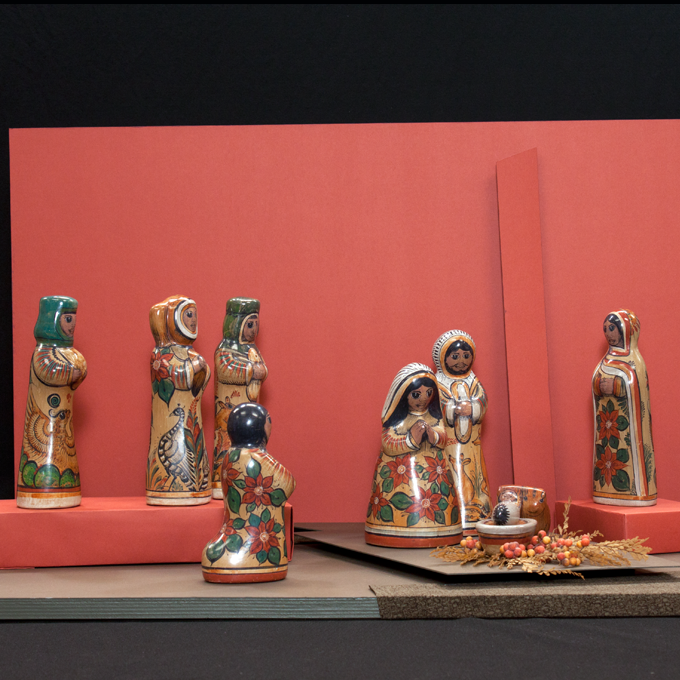
Wonders of Life
José Tomas Esparza León
The artist of this set is from Tonala in the state of Jalisco (Mexico). He has won Mexico’s presidential award for his art, and this nativity set was awarded first prize in the 1996 International Crèche contest in Bellingham, Washington. Esparza makes his nativity sets using pre-Columbian techniques inherited from his ancestors. The clay is dug from the hillsides near his town, and the dyes are all natural materials. The distinctive features of this set are the lively and varied design elements, mainly floral and animal figures interspersed with geometric ornaments. The ornamental figures are the real reason for this nativity set. Christmas rose, peacock or rabbit: they all proclaim, in so many voices, the wonders of life.
– ML.1114.09
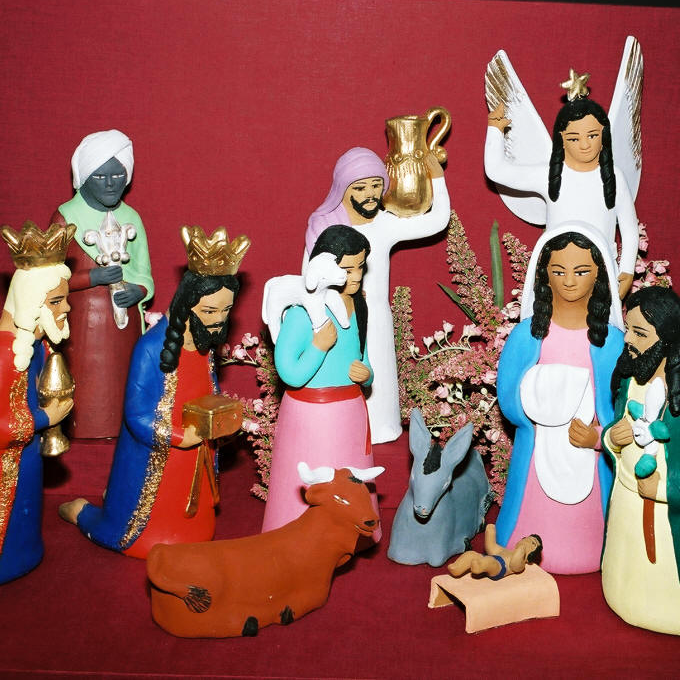
The Dark Side of Life
Irene Aguilar
Irene Aguilar is from Ocotlan de Morelos in Oaxaca. Oaxaca has its own distinctive nativity tradition. Mostly carved in wood, the figures tend to be angular and brightly colored. There is an air of mystery and drama pervading Oaxacan nativity figures. Their look is frequently somber, mouth and eyes sometimes bearing a cruel streak. Although not prominent in this set, the animals tend to be creatures of myth and evil fantasy. Ox and ass are frequently depicted as colorful monsters guarding the baby. They also act as scapegoats carrying the sins of creation to the manger.
– ML.1115.02
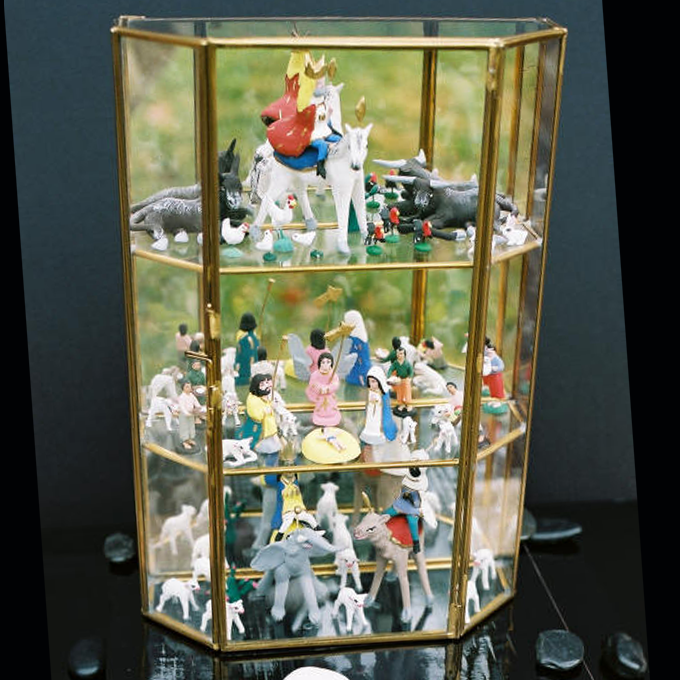
A Moveable Feast
Unknown artist
This three-tier glass case is home to a menagerie of animals ranging from chickens to camels, elephants, and horses—not to forget the grim-looking oxen with their immense horns and the placid but wizened donkeys. The glowing rose bushes, the billowing red mantles of the wise men, and the devoutly crouching elephant: they all have their own story to tell. The set is a children’s paradise.
It is also a miniature paradise and a moveable feast. There exists a rich tradition of miniature nativity sets. We find nativities in matchboxes, in miniature churches, and tiny gourds. The origin of miniature religious objects has to do with traveling. Moving from town to town, civil servants and priests took with them a moveable altar, reliquary or icon. They were miniature in size. Today, miniature nativity sets remind us that Christmas is a moveable feast destined to travel time and space.
– ML.1115.03
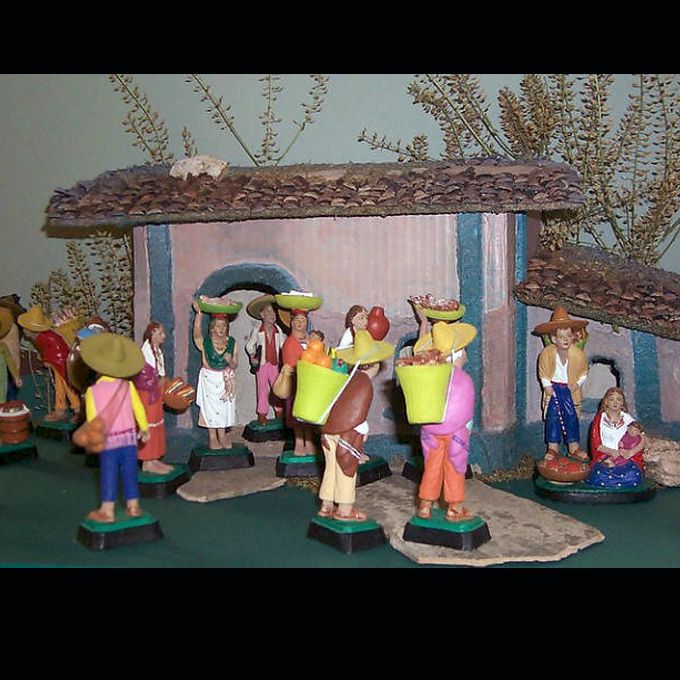
Hats Everywhere
Unknown artist
There are all kinds of hats: hard hats, high hats, tin hats and wool hats; there are even hat racks and hat tricks! The hats in this set are sombreros. Their first and immediate purpose is to give shade and coolness, but the deeper meaning reaches into the soul of the Latin American people, the men in particular but not exclusively. Sombreros speak of dignity and decency, pride and – as some would say – manliness.
There is another meaning still. People with hats are on their way; they are pilgrims or simply busy moving around. Even Joseph in this set wears a hat and carries a back- basket. Indeed, the holy family is only passing through. They stopped for a moment at one of the street corners at the marketplace. Soon they will disappear among the multicolored robes, scarves, shawls, veils, and, of course, hats of many shades. There is little physical and vestimentary difference between Mary, Joseph and the baby, and everybody else. God does not make waves when he comes. A marketplace or street corner will do; the proximity to the tavern does not repel him. What counts is attentiveness, the ability to find him among the many hats.
– ML.2611
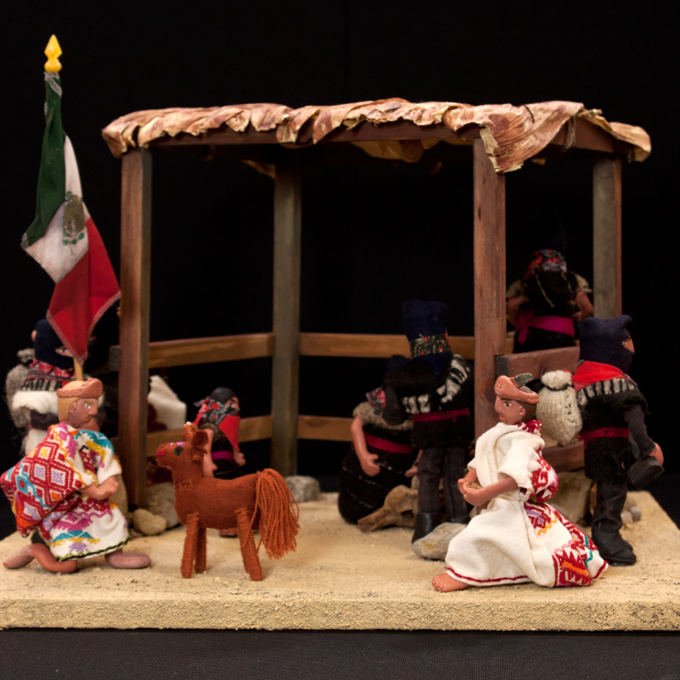
Empty Hands
Chiapas Indians
The primitive hut covered with banana leaves is the scene of a potentially violent drama. The quarreling factions can be distinguished by their dress code, and even better by their hands. Those in rich garb have empty hands, some of the others, muffled in red and black with balaclavas partially covering their faces, carry guns. Jesus and his parents are among the latter – they are the good guys. The bad guys are roaming around the hut with evil eyes. In vain they disguise themselves as the three wise and generous magi. They are wolves in sheepskin, hypocrites and usurpers. They are also charlatans: the clump of gold in their hands is fake. Such at least is the perception of the good guys, the downtrodden and poor. They carry backpacks and guns – symbols of revolt and despair. This nativity set has roots in contemporary history. It comes from Chiapas, a southern region of Mexico, and makes allusion to the Zapatista insurrection of recent years. Should Christmas be politicized? If Christmas means universal healing in mind and body, then the righting of wrong is necessarily part of the program of redemption. But Christmas is also a lesson about method. In the end, it is the babe in the manger and the man on the cross who brings about salvation. And so there are two kinds of empty hands. Empty hands that taunt hardship and misery, those of the roaming "magi"; but also those that drop the guns and take off their balaclavas.
– ML.0175.03
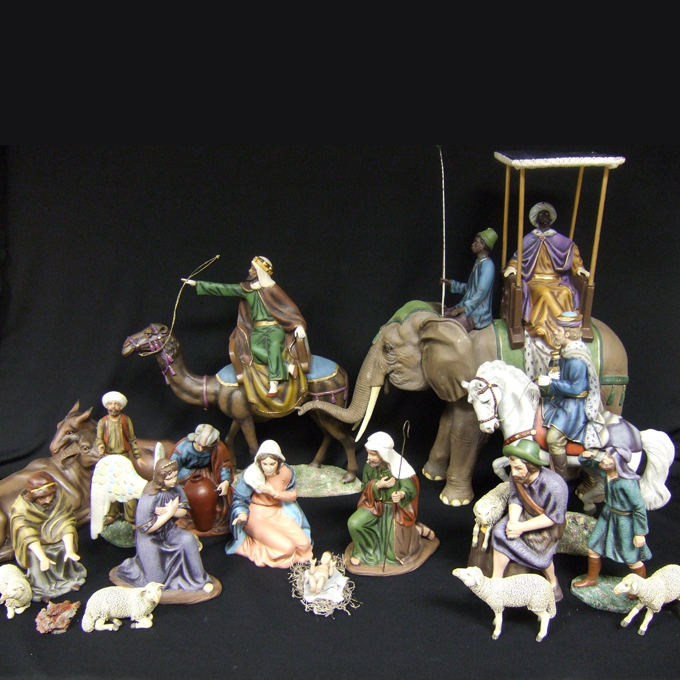
Horse, Elephant and Camel
Unknown artist
The classical beauty of these figures would suggest an Italian or German origin... In fact, they are Mexican. There exists in Mexico, where Christmas lore is abundant and varied, a modest crèche tradition which goes back to the last century and the ephemeral reign of the luckless Emperor Maximilian. He brought to the new world samples of Austrian craftsmanship: a mixture of peasant style, gothic revival, and recently-discovered orientalism.
The most prominent feature in this tradition is the three kings. Dominant, not to say domineering, they command attention. Dwarfing all other figures on their way, including the heavenly messenger, they do not look like weary God-seekers. Indeed, they no longer seek, they have found. The long, perilous and exhausting journey has reached a happy ending. The three beautiful animals stand for the inner dispositions or human qualities that made this relentless search possible. The impatiently snorting white horse which carries Melchoir, the King of Europe, is symbol of fearless enthusiasm without which no journey was ever begun. But enthusiasm needs to be sustained by sheer bottomless energy as symbolized in the monumental elephant which shoulders effortlessly not only Casper, the African king, but also his throne, canopy and driver. The camel is a symbol of endurance and right direction. The desert represents no threat and holds no secret for this animal. It leads King Balthasar, and his companions, patiently and securely to the even greater King's manger.
– ML.2414
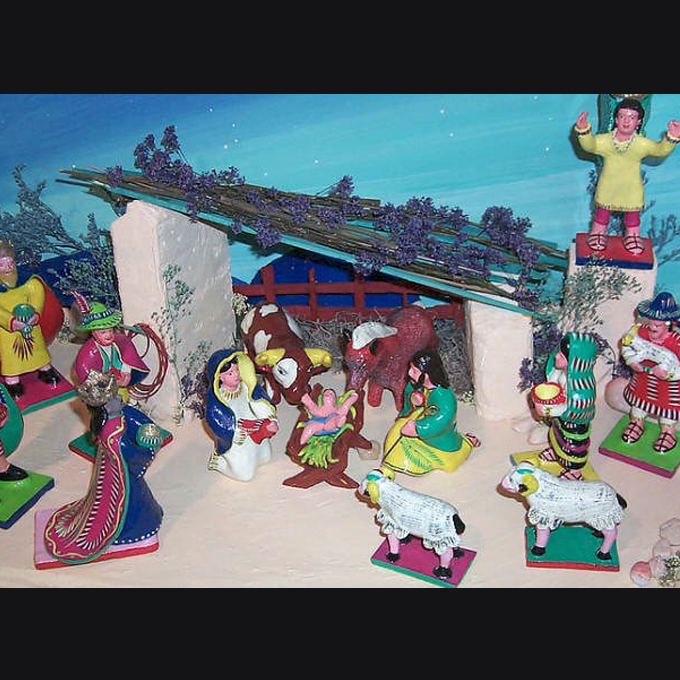
Only A Taste
Gerardo Ortega López
One of many, and sharing with other sets the many classical features of Christmas, Ortega's prize-winning figures give us only a taste of what the Christmas event may mean to us. Taste is what counts. It makes a difference. It adds a new color, and gives a second identity to what has become all too familiar and fits our mind like a worn and comfortable glove. Tasting, which should lead to developing-a-taste-for, is the beginning of interest and of a possible future commitment. This set attempts to do just that. Figures and setting are of "ordinary" beauty but the many exquisite details show that the artist has made the message of the nativity his own.
This birth story in painted and glazed terra-cotta is like a beginning gospel. It reveals the significance of Jesus in miniature, and helps us to acquire a taste for him and the more adult features of his message.
– ML.0614.02
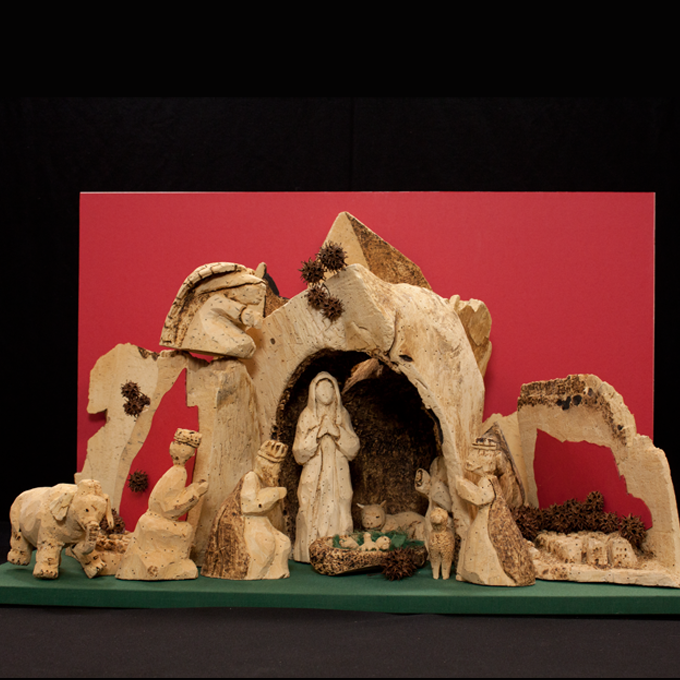
Angel and Devil
Palsied People
Carved from the soft and worm-eaten wood of a cork tree, this set creates the impression of a ragged and rocky terrain. At its center, there is a cave built into the tree trunk which shelters the baby and his parents. The figure of Mary, standing upright and silhouetted as Our Lady of Lourdes, looms from the cave and dwarfs even the humble elephant who is begging to enter. Right and left of the cave are the minuscule streets and city blocks of "little town of Bethlehem." The most fascinating figures are the angel and the devil. The angel sits on one of the promontories surrounding the cave, and reverently watches over the Christ child. With his immense and streaming mane of hair and feathers he looks like one of the eerie and terrifying figures straight out of William Blake's illustrations of the Apocalypse. Behind his back, crouching literally between a rock and a hard place, is the coarse figure of the devil. The earliest and permanent adversary of Christ-Redeemer, he is a popular figure in many nativity scenes. For a time, he is held in check by the angel but for how long? The unknown artisans of this rustic and uncouth but moving creation are experiencing a most personal odyssey between heaven and hell of their own: they are palsied people.
– ML.1124.02
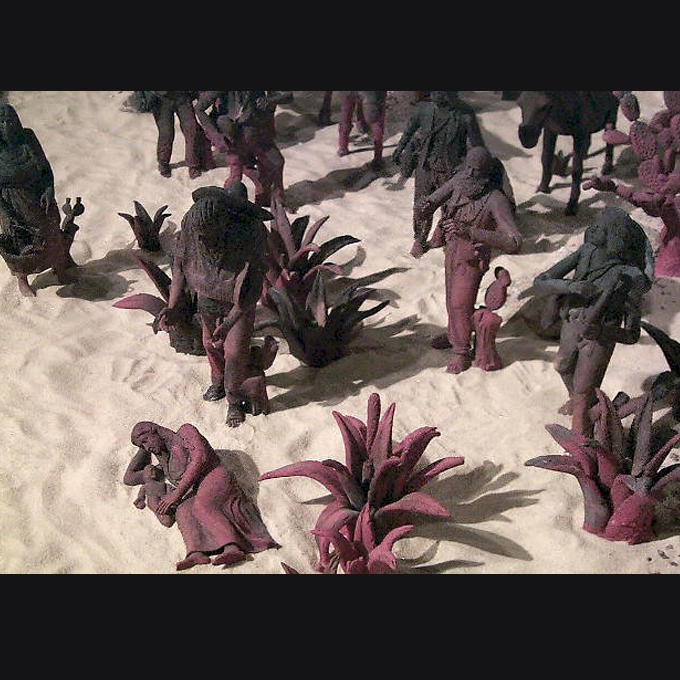
Rough and Tumble
Gochi Brothers
The harsh and barren landscape made of yucca and sand seems to suggest a man's nativity. Crafted by three rough and tumble men, three brothers, it takes some effort to overcome the initial impression of dirt and soot, or simply of careless endeavor. The high-fired figures, looking like coal miners at the end of their shift, are more than a product of simple craftsmanship. They are of exceptional artistic quality. The Gochi brothers have an uncanny ability to take clay and make it come alive with the minute details of daily life. There is more. The face and gestures of the figures are awash with the many emotions of the soul. See the triumph etched into the devil's sneering face, and big man Joseph's gauche and awkward gesture as he affectionately points to the child. From the creases of the men's shirts to the earrings of the women, this set tells indeed the rough and tumble life of gauchos or fortune-hunters. But this scene is not without the secret charm of intended or unintended poetic license: a handsome youth playing the lyre of ancient Greece in the Mexican desert; the bearded preacher who for once ceased thumbing his bible and squeezed it under his arm as he approaches the child; and, again the devil, Tequila bottle dangling from his belt, as he openly shows his horned head no longer hiding it behind a bull mask. Meanwhile, the baby rests in his mother's arm as she peacefully lies on the desert sand.
– ML.1119.09
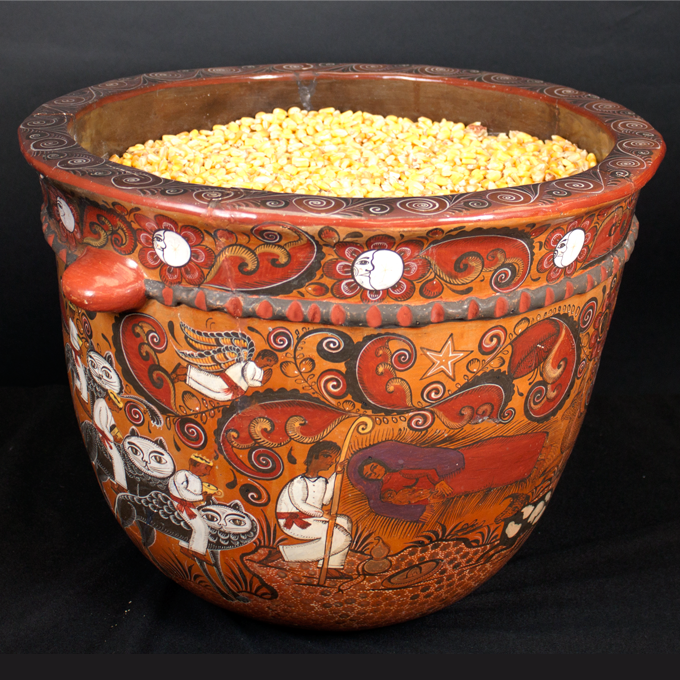
House of Bread, Corn Bowl
Angel Ortiz
Filled with the golden grain of corn, this bulgy jar is in its own way a house of bread. Corn is bread for many people of this country, just as Bethlehem is synonymous of food for body and soul. The jar tells the story of why it became the house of bread for Christians. A beautiful frieze which decorates the outside wall illustrates in four tableaus the shelter-seeking of the holy couple, the nativity in broad composition, the magi approaching in haste on lion back, and, squeezed in between Posada and magi, a battle of apocalyptic proportions between angels with pointed swords and the many-headed monster of the nether-world. The nativity dominates. It shows Mary in reclining position holding the child in her arm. She is surrounded in respectful distance by Joseph, his gourd and sombrero, and angels, shepherds and animals. The mostly male figures, angels included, are dressed in white shirts and trousers and girded with red fabric belts typical of Mexican campesinos. The man in the moon keeps a watchful eye on the proceedings.
– ML.1119.03
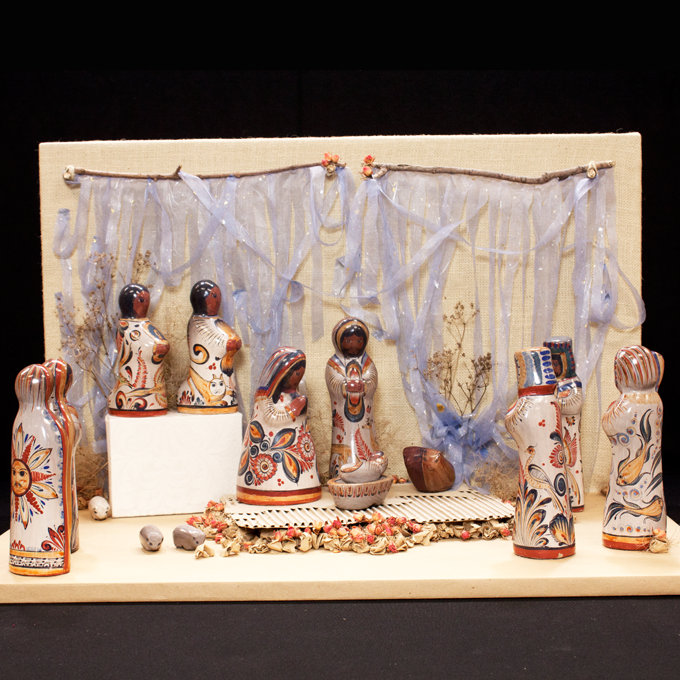
Hymn of Creation
José Tomas Esparza León
This set reflects one of many styles of Mexican nacimientos. It comes from Tonala (Talisco). Its figures are rounded and sturdy, providing the painter with much surface to demonstrate his skills. Influenced by pre-Christian indigenous culture, the personages are covered in front and back with artful ornaments, luxuriant flora and mythic animals. This hymn of creation, showing fish and fowl, rabbits and deer, is also a hymn to life and its manifold plenty. The figures, representatives of life in its various forms, are gathered respectfully around the very source of life, the Christ child. In contrast with life as it should be, exuberant and plentiful, the setting is humble and sober. It conveys the frequent opposition between material poverty and the riches of the soul, or, life as it could and should be and its unfortunate present reality.
– ML.0178.08
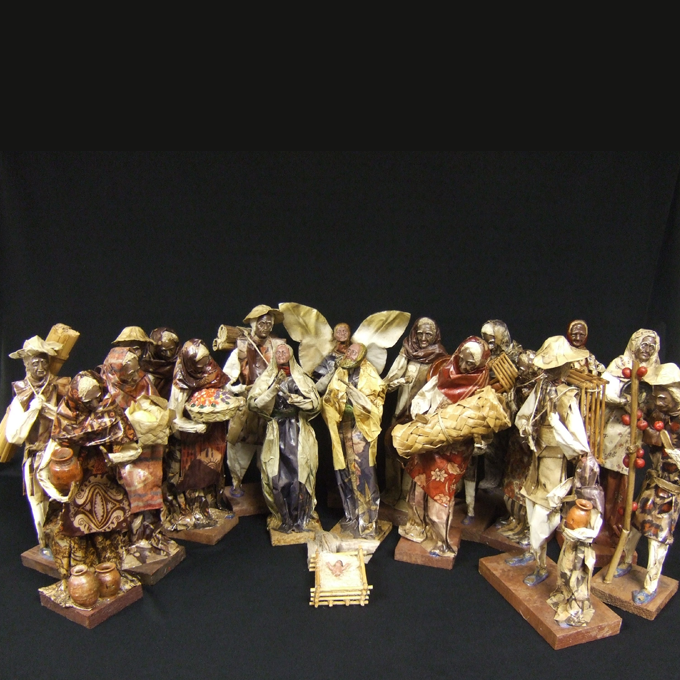
New Life and Old Skins
Raphael Arista
The paper-mache, of which this set is crafted, is a telltale sign. The procession of heavily laden folks represents people with fragile bones and parched skin. This is an old-folks nativity, indeed. It was created to honor the older generations among us. They bring a vast amount of life experience and achievements to the tiny Christ child. Their riches, not necessarily material wealth, are symbolized with full crates, rich pottery, and food of all kinds. They lead the way to the crèche for younger people. Originally designed by the artist to tell the seniors of his village that they were not a useless bother but an integral part of the community, this old-folks nativity makes a universal claim. It expresses gratitude to all those who went before us on the pilgrimage to find the humble Savior, and became pathfinders for us on a road always there but never the same.
– ML.1119.04
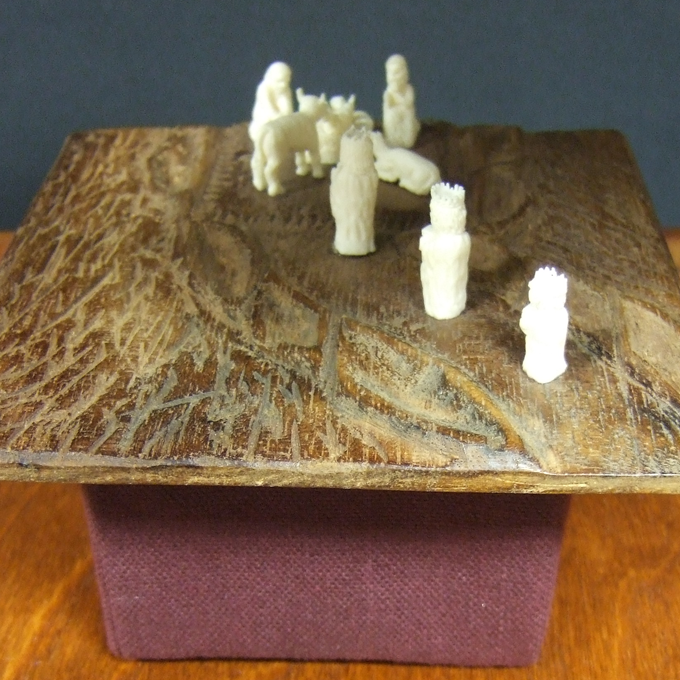
Carved in Bone
Plácido Hernández. López
A prize-winning set at the 1993 Bellingham International Crèche Festival, this mini- nativity is carved in bone. The artist, a Chontal Indian, was nineteen years old at the time. The tiny, tiny figures are carved with a remarkable sense of precision and realism. Admire the face of Joseph, and the meditative posture of Mary. See the artfully-decorated gifts of the magi. Enjoy the humor of ox and ass playing with the Child. If nativity sets are first and foremost a pastoral aid created by artisans to teach young and old about Jesus' coming in this world, they can also be, and frequently are, beautiful pieces of art, real artwork. This mini-nativity set in bone falls in the latter category of artworks. Learning is greatly helped when beauty makes learning joyful.
– ML.0163.12
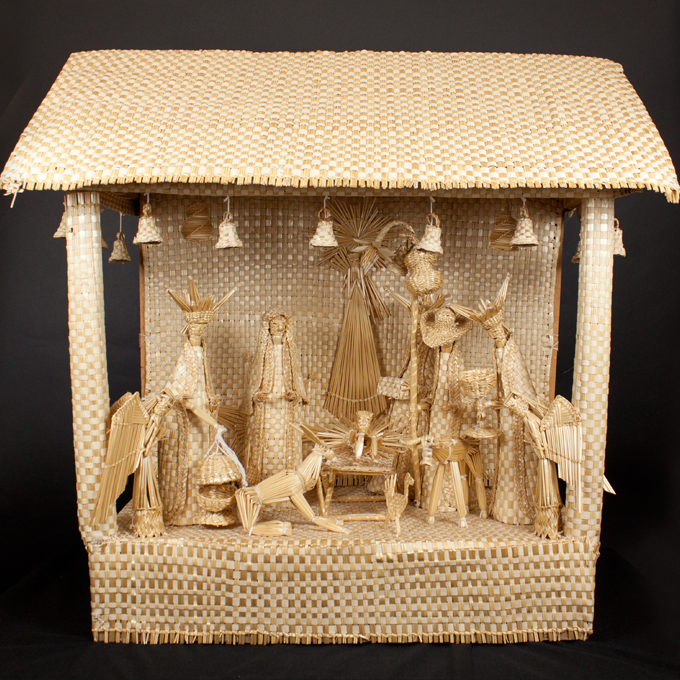
Lying on a Bed of Straw
Bernardino Marquez
When poverty and faith meet, they frequently generate inventiveness and creativity. This is the case for some of the more beautiful samples of straw nativities from the Tzintzuntzan region of Mexico. The artist of this set, Bernardino Marquez, is a master weaver who created some beautiful figures with a most ordinary material, straw. Decorative on large surfaces and intricate where small features are concerned, the artist's weaving produced figures of great simplicity and dignity. Admire Joseph with his blooming staff, the gourd hanging from its top, a pilgrim's hat (patterned after St. James') on his head. A golden glow emanates from this straw set, as if the ordinary material was ennobled by the noble purpose it served. As for the meaning of this nativity set, God is able to make beautiful things from humble beginnings.
– ML.1119.01
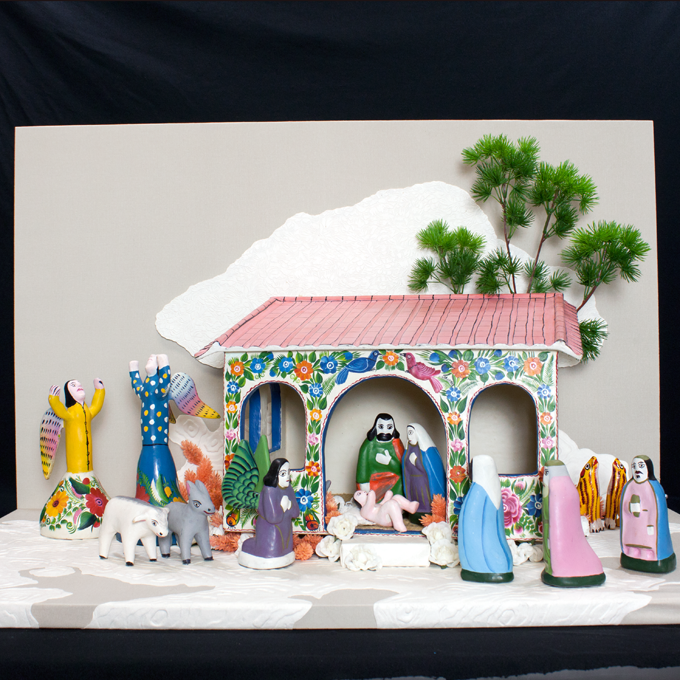
My House Is a House of Prayer
Unknown artist
This set from Guerrero, Mexico, is a good example of lacquerware of the area. The richly decorated house shelters a host of figures, not least two dogs barking mightily in honor of the newborn King. The house is flanked by two guardian angels standing upright in a posture of praise. The facial expressions of the figures are in the style of indigenous, pre-Christian culture. The faces are flat, but pointed in the center reflecting human dignity (pointed parts) and dependence on God (flat parts). The setting of this nativity, the house covered with flowers, reminds us of the meaning of church. It is the place where Christ is born and reborn every time the memorial of his death and resurrection is celebrated.
– ML.1119.25
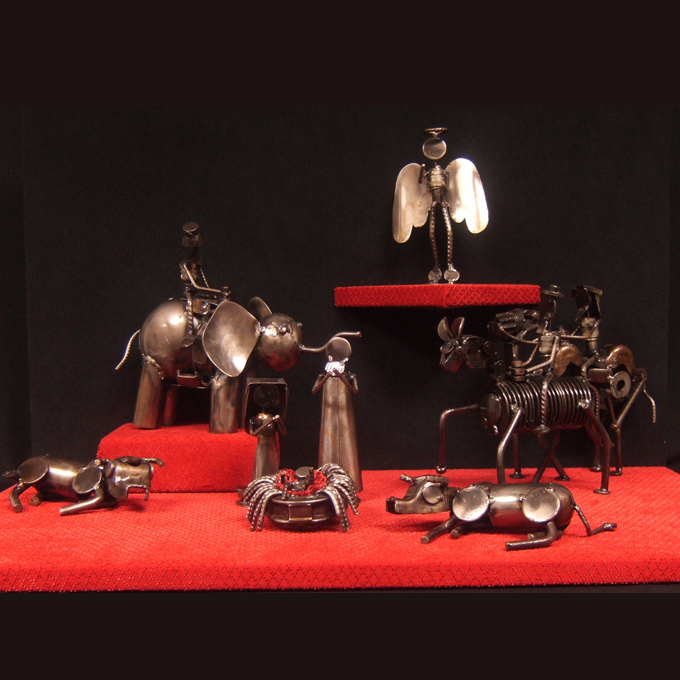
Out of Rubble and Wreckage
Armando Ramirez
There are times when child's delight and adult puzzle dovetail and merge. It happened in this nativity set. We discover the adult determination to bring the Nativity into the present age and culture, where sheep are no longer sheep but auto parts. Armando Ramirez's rustic nativity also reflects the delightful playfulness of the child, bringing to life what the adult eye rejects as rubble and wreckage.
– ML.2159
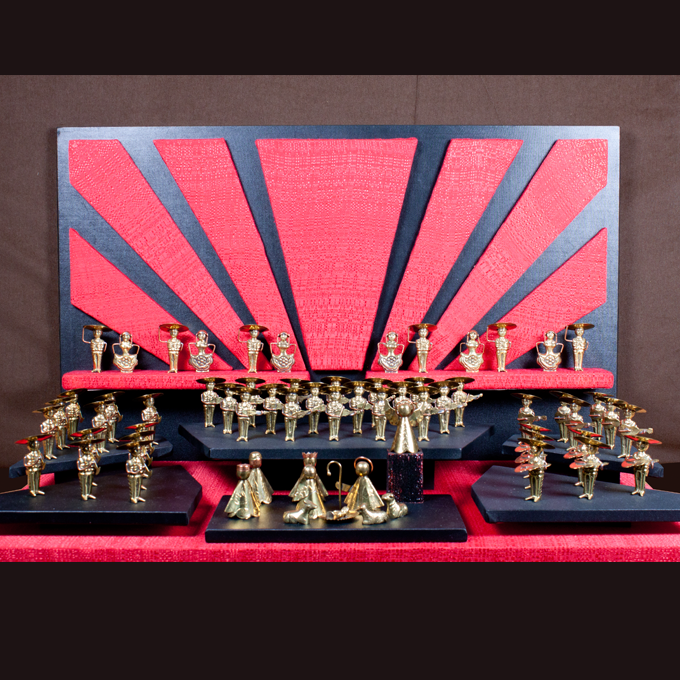
Mariachi Nativity
Unknown
This nativity is like an island in a sea of brass. But the brass is not just brass. This is a reunion of typical Mexican brass bands, so called the Mariachis. You can almost hear the festive and happy but also romantic and sentimental tunes of the mariachi musicians. Only one of the musicians made the tribune of honor with all the traditional nativity actors. He represents the many trumpets, violins, guitars, vihuelas (small five-stringed guitar with rounded back) and guitarrons (six-stringed large vihuela) artfully grouped on the lower level. The Mariachi tradition originated in the western state of Jalisco. It has become a symbol of Mexican music and culture. And so, in this Mexican set, the Christ Child's advent is hailed with the consolidated sounds of many Mariachi bands incorporated.
– ML.2621
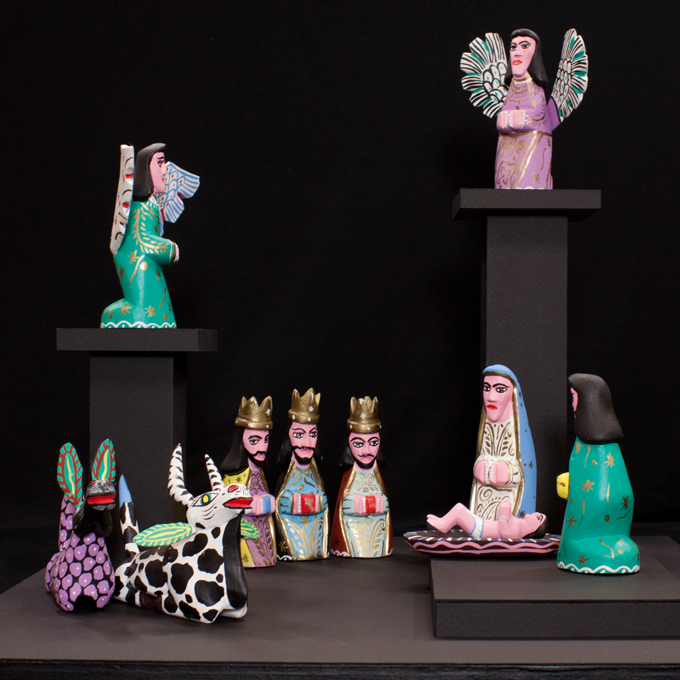
High Level Conversation
Juan Melchor Ojeda
The distinct traits of this Mexican region are bright colors and mask-like faces. Oaxaca. artists practice the art of drama. In this Nativity drama, the actors' expressions are solemn and mysterious. They suggest a tableau rather than a play. A tableau or scene, much talked about in a "high level" conversation between the two angels (see the elevated position of the two angels!). Indeed, stories about angels debating the birth of Christ, its possible failure or success, abound in Christmas lore. They add drama to the event. Oaxacan nativities usually hold an element of enchantment, too. Ox and ass are far from being the baby's plain and humble companions. They are the fabled animals of age-old myths inspiring awe and wonderment. If their figures are awe-inspiring, their Christmas message is plain and confident: "There is more here than what meets the eye."
– ML.0127.01
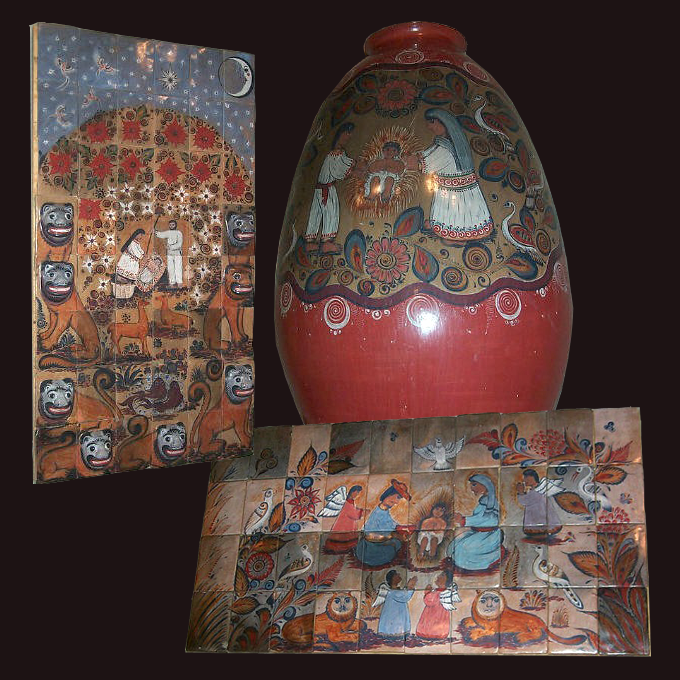
Jar and Tiles
Josè Tomas Esparza
The central scene of each nativity is situated in a luxuriant but stylized Eden filled with peacocks, butterflies, deer and watchful lions. The awkwardly drawn figures of the holy persons strangely contrast with the sophisticated ornamental elements, namely symbols of plenty and eternal bliss. The reddish-blue hues of the finely painted decor blend in handsomely with the rich brown color of the terra-cotta. The vertical tile mural is especially impressive. Eight formidable lion heads are emerging from the tiles in bas relief fashion. The artistic affinity between these two-dimensional representations of Christmas from Mexico picturing Nahual figures, and the many Pueblo nativity sets is obvious. In both cases the human figure (as well as that of animals) is treated with extreme economy whereas great artistic attention is given to decorative elements.
– ML.1117.01
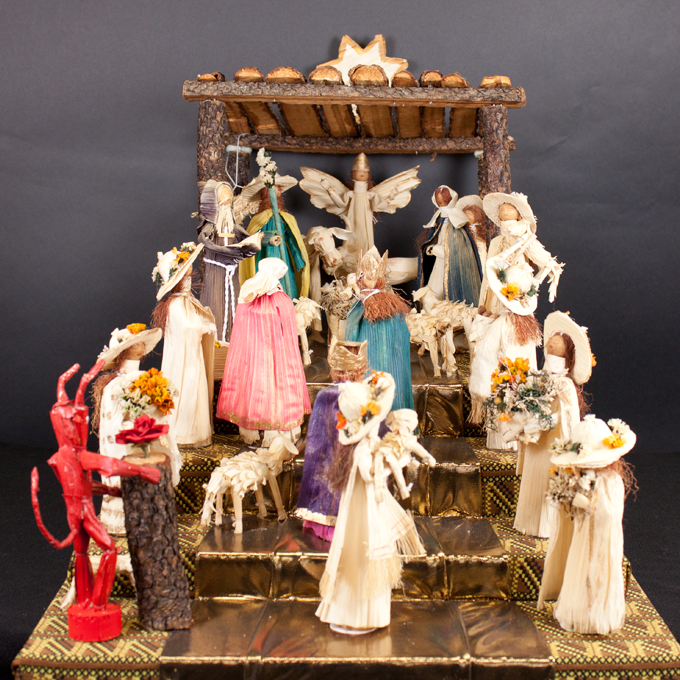
The Red Devil
Unknown artist
A very artisanal crèche at first sight, this nativity set has its own charm, originality, and humor. Made of humble materials, cornhusk and wooden sticks, the many darling figures have a life of their own. Speaking of charm, take a look at the swarm of ladies with their wide trimmed and blooming hats, and, for some, with colorful bouquets of flowers in their hands. Aren't they dressed and ready to ring in the joys of Spring? As to originality, have you ever seen a monk gracing a nativity set? He is -- usually a Franciscan monk -- the announcer of the Christmas story. For that reason he is the first figure to appear in the crèche at the beginning of Advent. At the bottom of the sumptuous stairs there is a red devil. He is there to be made fun of. The role of his tribute is attached to a tree truck. He is the laughingstock of the noble ladies for how will he ever get the rose to the manger!
– ML.2443
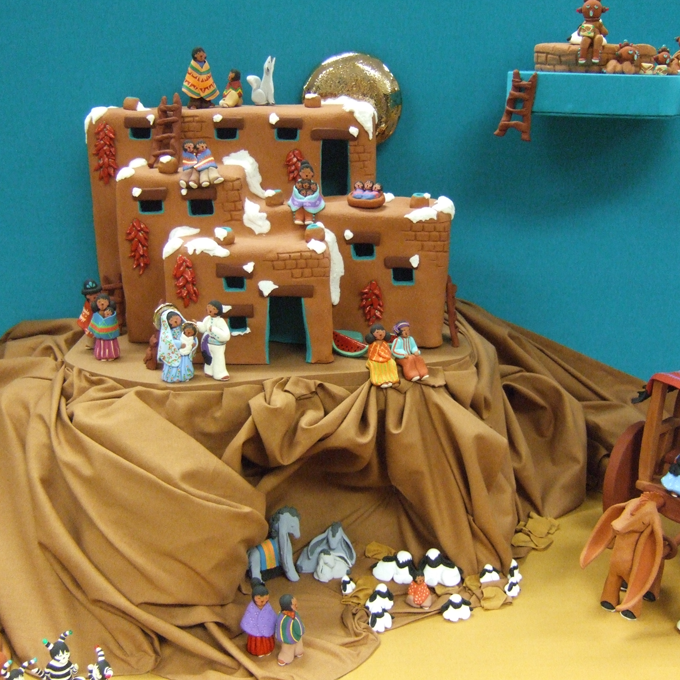
Sun, Peppers and Snow
Jil Gurulé
The untrained eye may get lost in this amazing variety of people and animals who seem to have escaped a beautifully illustrated book of fairytales. Luckily, there is this imposing structure of piled up little homes which somewhat contains the abundance of colors and the flow of village life. We are no longer looking at a single house, but at a whole village. Built in the style of a southwestern adobe, the village evokes the image of a staircase leading the visitor on and up to meet the rising sun. The Holy Family dressed in their finest Sunday best is not confined to a particular space. They do not need shelter. The village and its people is their home. The outside walls of the village are decorated with chaplets of peppers and slivers of snow. They are symbols of life: peppers for spice, snow for hardship. The real spice of life is made of both peppers and snow for all of us, the Holy Family included.
– ML.2629
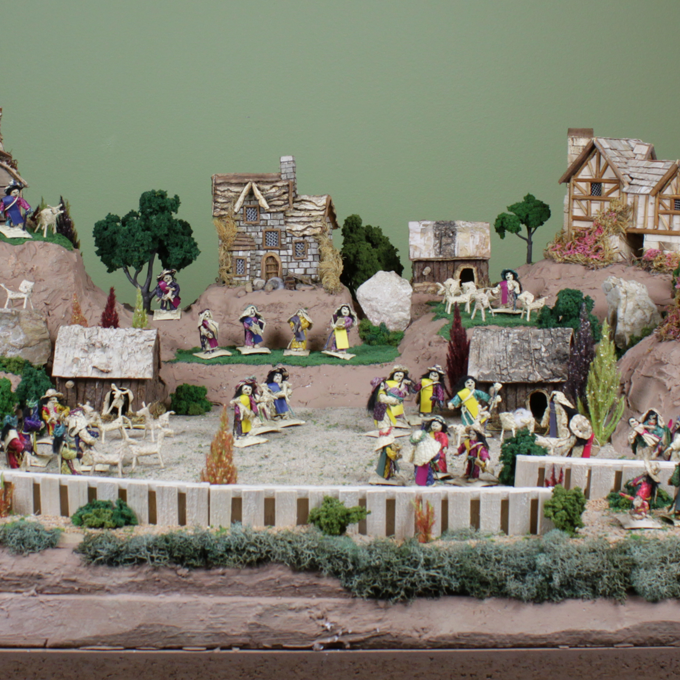
Nanos for the Christ Child
Unknown artisan
Straw and bark
Mexico and USA
Try to bring two different worlds together and there will always be a discrepancy of either gender, race, or color. Unity never effaces diversity. The architecture in this set is of Northern make-up, the little people peppering the landscape sprang from Latin imagination. Unity is based on external reason, most of the time. What brings these two worlds together is the promise of a new world gathering the best of all worlds in what Christians call the Kingdom of God.
The tiny little people are nanos -- like in "nanotech"! -- for the Christ Child. They remind us that all of creation down to the molecular and atomic scale is permeated with the love of God in Christ Jesus.
– ML.4954
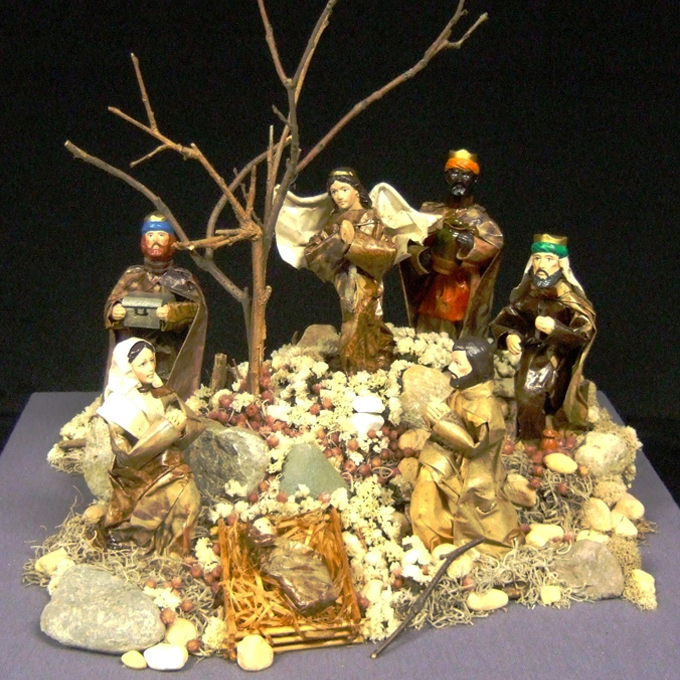
The Show Must Go On
A. Camarro
For some people there is nothing like paper-maché to give them a sense of creativity and creativeness. Ingredients to make paper-maché are easily available: water, flour, and strips of paper, newspaper in particular. The directions are simple: mix flour and water, prepare a smooth paste, dip in the paper strips, lay the coated paper on the form
to be paper-machéd until completely covered, let the surface dry, and paint your own design. Paper-maché is the bronze of the poor, the marble of the apprentice artist. The shiny varnished figures with fixed gaze, the all-star of paper-maché, may be only lightweights and their existence, short lived and fragile, but their message has lasting value.
We have not been fashioned by the hand of Michelangelo, they tell us, we are not great actors and have only a walking part. We also know that beauty is ephemeral. Tomorrow we will be gone, but the show must go on. Other shiny varnished figures with fixed gaze will take our place, for as long as there is time the drama of Incarnation must be re-enacted.
– ML.2640
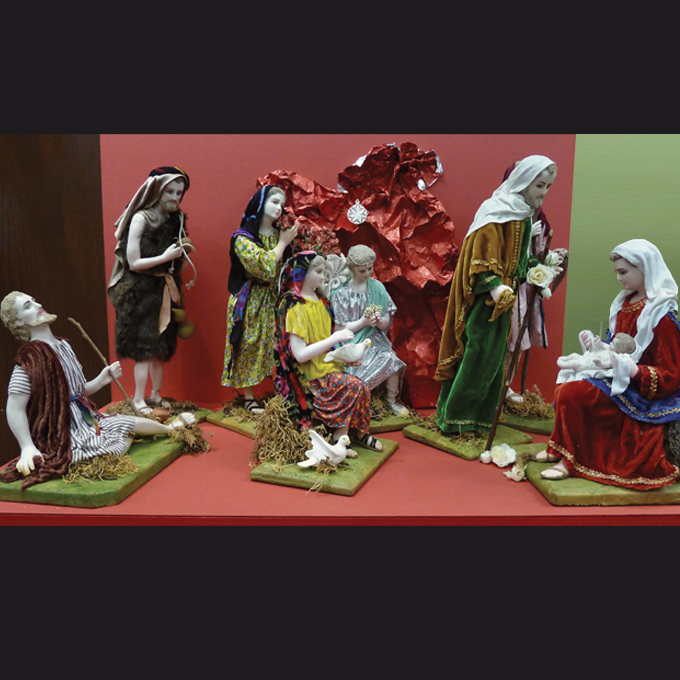
Of Fragile Beauty
Angelita Gutierrez
This set is part of a fifteen-piece nativity from Mexico. The figures are cast in wax and draped in rich and colorful robing. They convey an atmosphere of dignity, peace, and silent prayer. The whole scene is a still life of adoration pressed into wax. Wax is a fragile material. The figures are of fragile and almost translucent beauty. They symbolize the greatness and fragility of our faith in the God made man.
– ML.2643
